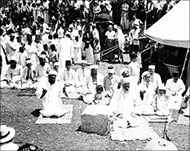A faith on the verge of extinction
No catalogue of Palestine would be complete without mentioning the Samaritans, the ancient quasi-Jewish sect mentioned in Islam and the Bible.

Adherents of the faith present themselves as one of the most ancient monotheistic communities in the world.
With their total population not exceeding 650, the Samaritans may well be the smallest ethno-religious community in the world today.
In light of this, survival seems to be their main preoccupation.
Palestinians and Israelis
Today, nearly 320 Samaritans live in Nablus, the largest town of the West Bank, which they view as their historical homeland and principal religious centre.
The other 335 people live in Holon near Tel Aviv.
The Nablusite Samaritans are full Palestinian citizens and are represented in the local municipal council as well as in the Palestinian Legislative Council. Those living in Holon are full Israeli citizens.
Samaritans in Nablus bear both Arab and Hebrew names, the Arab names being used in public life and the Hebrew names in private life and at religious ceremonies.
Moreover, all Samaritans in Nablus speak Arabic making it difficult to distinguish them from other Palestinians.
However, religious rites and services are conducted in an ancient Hebrew dialect Samaritans claim goes back to the era of the early Israelites.
Samaritans argue that the Hebrew spoken now in Israel is a confluence of the Assyrian and Aramaic languages.
Authentic Judaism
According to Abd al-Muin Sadaka, the highest-ranking religious leader of the community, Samaritans follow “authentic Judaism”.
 |
|
Abd al-Muin Sadaka a leader |
“We only recognise the five books of Moses (Genesis, Exodus, Leviticus, Numbers, Deuteronomy). We don’t believe that the rest is from God,” says Husni Sameri, who is in charge of the Samaritan museum and cultural centre.
The religion is based on five pillars: Belief in the one God, that Moses is God’s messenger, belief in the first five books of Moses, especially the Ten Commandments, belief in the holiness of the Jerzim mountain, and finally belief in the day of resurrection.
Most Samaritans believe in a sixth pillar, namely the belief in a prophetic figure descending from Moses who will appear toward the end of time and spread justice throughout the world.
Samaritans treasure a Torah scroll at their community’s museum in Nablus which they inherited allegedly since Aaron, Moses’ brother.
This scroll, they say, is the oldest existing Torah in the world, written by a fourth-generation grand child of Aaron.
Population decline
According to Sadaka, the Samaritan population reached 1,200,000 nearly 1400 years ago. However, this number dwindled steadily until it reached an all-time low of 146 in 1946.
Sadaka attributes the near extinction of the community to intermarriage, assimilation, and “forced conversion” to other religions, especially Islam, a claim denied by Professor Abd al-Hafidh Shuraida, dean of the Islamic studies department at the Najah University in Nablus.
Today, the biggest problem facing Samaritans, especially in Nablus, is the decreasing female population. According to Sameri, there are only four females for every five males.
“This is a real problem and we don’t know how to resolve it,” he says.
Marriage rules
Sameri says their religion prohibits marriage outside the community “unless the outsider, whether male or female, is willing to convert to the Samaritan faith and join the Samaritan community.
“Any Samaritan who marries outside is no longer a Samaritan,” he says.
 |
|
A sacrificial ceremony held on |
In Israel, the problem seems to have been overcome, at least in part, as a number of Samaritan men married Israeli Jewish women who embraced the Samaritan faith.
However, the problem in Nablus remains acute since, as Sameri says, Muslims are unlikely to convert.
In fact, at least two Samaritan youths chose to convert to Islam and, according to Nablus journalist Amin Abu Warda, have been excommunicated by the elders of the community. One of the converts is a female student who has married a Muslim.
According to Shuraida, who has written a book on Samaritans, the occurrence of mental and physical disabilities is much higher in the Samaritan community than it is in society at large.
Shuraida attributes this to intermarriage within the sect or even the immediate clan.
Bon accord
Samaritans in general praise Islam, which they view as vindicating their religion.
“Without Muhammad, no Samaritan would have remained on the face of earth,” Sameri told Aaljazeera.net, alluding to the designation of Samaritans by Islam as “people of the book” who should be protected and respected.
Indeed, despite their esotericism and religious insularity, the Samaritans seem to be integrated in the Palestinian social fabric in Nablus, both socially and economically.
“We are an integral part of Nablus. We are more than good neighbours. We are brothers and compatriots,” says Sameri.
His remarks are readily corroborated by Palestinians.